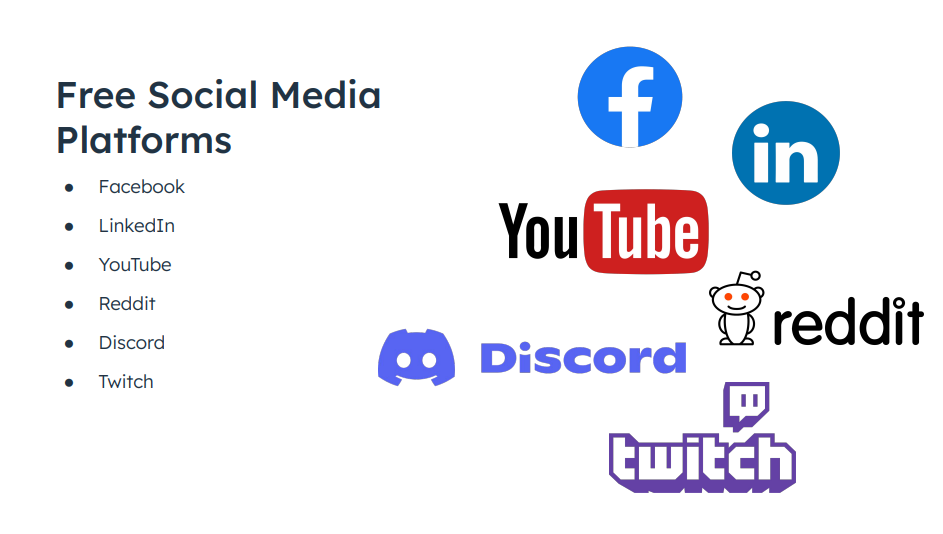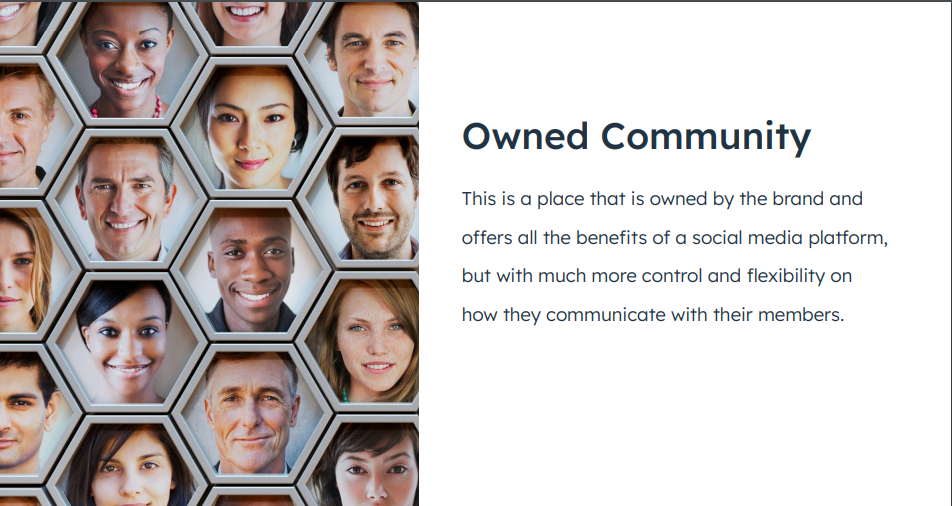Building a social media community or refreshing an existing one is a process that requires some planning to ensure success. The best way to start is by determining the reason you’re building the community in the first place. Reasons may be that you’re trying to support your existing business or marketing e orts or that you’re wanting to counteract negative reviews and identify passionate fans.
Whatever the reason may be, there are a few questions to ask yourself to determine whether creating your own social community is right for you. First, why should I engage with my customers online? Look at your business goals. Will building a community help you reach them? For example, if your goal is to increase brand awareness, a social community can help by providing a platform for customers to share positive experiences and recommendations with their own networks. If your goal is to increase sales, a social community can help by providing a direct channel for customers to purchase your products or services.
Then, what resources do I have available to ensure the success of my community? You’ll need people to help create content and to engage with your community. Will these people be in-house or will you need to work with an agency? Remember, creating content can cost you money. Thinking a bit about your content strategy ahead of time will help you budget for your community.
Here’s Sakibul Hasan, director of community at Nexorank to share more.
Sakibul: I’m often asked, “Great, we want to invest in this, but headcount is scarce. Do we really need to hire someone to run this community?” And I have slightly conflicting answers here, in that, at the beginning, absolutely, you, as a leader within your organization, should be deeply involved in your community. You will not understand it and the community will not feel the care unless you’re actually part of launching your community. But a community is something that requires a lot of care. It’s a living thing.
It’s your bonsai tree. And if you neglect it, it will su er. And so, having someone who really lives and breathes community, spends their day thinking about the community and caring about the community will make it far more successful. And it may feel like, oh, that incremental headcount, like, that’s just too much. But the fact of the matter is data has shown a dedicated community manager is going to make your community more successful, and it’s going to allow you to do things like quickly respond to people, deal with problems as they come up, moderate your space to ensure that you are creating the warm fuzzies that you want in your community. You also need to think about the type of content you’ll share in your community. This can include product or service information, industry news and updates, tips and tutorials, user-generated content, and promotions or discounts. Additionally, it’s important for the brand to be authentic and engage with the community by responding to comments and questions, and creating opportunities for community members to interact with each other.
Managing Your Online Community for Long-Term Success
Apart from the content, do you have the means to manage this community long-term? Too often, brands put together communities and later abandon them. There could be a variety of reasons for this, like mistakenly thinking the communities can manage themselves or there being shifts in people and resources. But leaving your community hanging may turn loyal members into disgruntled ex-customers who could do damage to your brand. To prevent this, you need to determine up front what your long-term commitment will be, and if plans change, how you will manage any transitions for your community.
This lends to how you’ll moderate the community. This question is not just about how many people you may need, it’s about whether you’re prepared to create guidelines for your community and a system for enforcing those guidelines. Online community guidelines should include rules and expectations for behavior within the community, such as those around respectful communication and prohibited behavior, like harassment or hate speech. They should also include information on how to report violations and the consequences for breaking the guidelines .
Think about whether you’re more interested in creating content conversation. If it’s the former, then a community isn’t the right path for you. The conversations in your community may help you come up with a million new content ideas, but it’s a lot of work to regularly engage your community, and if you aren’t able to put the time and energy into talking to your audience, then you won’t be able to reap those benefits.
Now it’s time to figure out how you’ll measure success. This question ties back to those business goals once more. Are you looking to monetize your audience in some way by providing exclusive access to product o ers? Are you hoping to drive word-of-mouth by incentivizing user-generated content? Are you looking for product feedback? Consider ahead of time how you’ll measure the success of all the conversation and collaboration that takes place in your community.
Let’s hear more from Christina Garnett, principal marketing manager, o ine community and advocacy at Nexorank.
Christina Garnett: Community goals are absolutely priceless. I find that a lot of communities su er because businesses are unable to align what their goals are with the community’s goals. So when you’re building a community, you need two di erent types of goals: goals that align with the business goals as well as the member goals.
It’s really easy to forget that the members have their own motivations and goals when being a part of a community, and you need to make sure that you find that balance between how is this community helping the business? It could be through retention, net new, or content creation. And then how is it actually serving and meeting the motivations of its members?
Last but not least, you need to think about what the best platform is for your community.

There are free social media platforms, like Facebook, LinkedIn, YouTube, and Reddit, and other platforms, like Discord and Twitch, that began as gaming communities but have begun to spark the interest of business marketers. You’ll need to do a little research to determine where your audience is and which platform best fits your overarching goals. Check the resources section for guides on how to create communities on these platforms.
Another option is to build an owned community. This is a place that’s owned by the brand and o ers all the benefits of a social media platform, but with much more control and flexibility on how they communicate with their members. For example, if you launch a blog or website with a forum or comment section for your visitors, this is an owned community that you can manage yourself. You can also use third-party community software providers to leverage your community.
Why Building a Community Can Amplify Your Brand’s Impact: Scale, Passion, and Perspective

Abrand should consider building its own community if it believes it’ll benefit from sort of the three aspects that I think communities do really well. One is scale. Communities can bring together a lot of people to do a small amount that leads to a big outcome. The second is passion. Communities can help really build and grow passion in a group of people. And then the third is perspective. People love to hear from others like them, and community is a great way to bring in perspectives that you, as a brand, maybe can’t represent. And so, if one of those things is extremely valuable to you, it may make sense for you to build a community. It can help you scale your costs through that scale aspect. It can help you activate your advocates through your passion. And it can also help you show people more aspects to your product that you might not be able to represent yourself.
Exploring the Decision to Create a Brand Community: Factors to Consider and Strategic Partnerships
So if you’re a brand and you’re wondering whether or not you should create a community, the answer isn’t always yes. It really depends on your goals and what you want the outcome to be. It also depends on whether or not that community already exists, and maybe it’s already been created without you. A really great example of this is the Peloton community. Even though they have their own central community and ways to
be able to interact within the tool itself, there are tons of Facebook groups and hashtags that you can see as di erent ways for people to self-identify how they’re being a part of that. And so, what I would recommend, is do some social listening across di erent channels. Do general Google searches and find out who are the people that are using specific keywords, what are these communities like, and how can you align with them? How can you play a part and essentially see it as more of like a partnership? This is great for brands who don’t want to do the heavy lifting, who don’t have the budget to create a community team, and also aren’t sure if this is a long-term play for them. A lot of communities su er because brands want a low lift, quick win, and community is really the opposite of that. So if you’re wondering about whether a community is right for you, consider partnerships and if there’s a community that already aligns with you.
If you represent a brand with a strong social media following, you may want to consider how you can foster a sense of community across your channels — perhaps by providing an owned community on your site that draws your social followers in through an incentive from the various social channels they’re on. This incentive could even encourage them to develop user-generated content that you can then proliferate across platforms.
This is where a brand hashtag can really shine. A great example of this is #SephoraSquad , an exclusive community developed by Sephora for creators and influencers that helps the company build brand buzz across the Internet. Check the resources section for more examples of successful social media communities.
Evan Hamilton is also a fan of Sephora for their Beauty Insiders Community because they’re a great example of a strong community-led growth strategy.
The Power of Community: How Sephora’s Beauty Insiders Program Drives Engagement and Sales
One of my favorite examples of a business successfully running a community is the Sephora Beauty Insiders community, because this takes the aspects of perspective, scale, and passion, and combines them all into one space. Makeup, style, and fashion are incredibly subjective topics, and they’re one where people want to hear other perspectives. They want to know, “How does this work with my skin tone or my style? How does this work with these other products I use?” There’s no way Sephora will ever be able to create content that covers all those topics in a way that feels genuine and legitimate.
And so they created a space, Sephora Beauty Insiders, where their customers can come together and talk about the products they’re currently using, the styles they’re currently creating, the ways that they’re dealing with skin care. And they are deep, robust conversations that are so specific to individual people, their budgets, their style, who they are as a person. It’s immensely valuable to the members of that community, and it’s immensely valuable to Sephora because they’ve seen huge increases in spend from the members of these communities because they’re constantly being exposed to new products and human beings, who they believe most of all, talking about why those products are so great and how to use them. It’s a perfect example of giving and getting. Sephora focuses that space on this is for you, for you to learn, for you to support each other. It’s an incredibly safe and supportive space. And then Sephora is reaping the benefits because people appreciate the brand more, talk about the brand more, and are buying more product.
Creating a social media community is a sizable project, but with the right planning and resources, you have an opportunity to drive customer engagement that can transform your business.



















